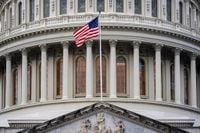As the global economy enters a pivotal week, investors and policymakers alike are bracing for a flurry of economic data releases and political events that could set the tone for the remainder of 2025 and beyond. Malaysia, in particular, finds itself at the center of attention, with key trade and inflation figures due, while international markets continue to digest recent volatility and the aftershocks of the longest US government shutdown on record.
According to The Edge Malaysia, Malaysia’s economic calendar is front-loaded with two significant data points: October trade performance, set for release on November 19, and the Consumer Price Index (CPI) on November 21. These releases will give investors a clearer picture of both external demand and domestic price pressures as the year draws to a close, influencing everything from corporate earnings to currency movements and policy expectations.
Bank Negara Malaysia, the country’s central bank, issued a note of caution on November 14, warning that future exports could be weighed down by tariffs and a moderation in external demand. However, the bank also highlighted ongoing support from robust electronics exports, a rebound in mining-related shipments, and a recovery in inbound tourism. The third quarter saw a notable rebound in net exports, with exports outpacing imports to grow by 17.7%. In September alone, exports rose to RM138.68 billion, marking a 12.2% increase compared to the same period last year.
DBS’ Economics and Strategy Research team expects this momentum to continue, projecting a 10.5% year-on-year expansion in goods exports for October. The team attributes much of this growth to electrical and electronics (E&E) shipments, which have remained resilient despite the headwinds of a 19% US reciprocal tariff. As stated in their November 14 report, "E&E strength was likely consistent with regional trends, amid US tariff exemptions on electronics goods and sustained artificial intelligence-related demand."
Inflation, however, remains a topic of close scrutiny. DBS forecasts headline CPI inflation to tick up to 1.6% year-on-year in October, marking the fourth consecutive month of modest increases. This uptick is partly driven by rising services inflation, a result of an expanded sales and services tax implemented since July. The impact of targeted RON95 fuel subsidy reforms, introduced in late September, has been limited so far, thanks to manageable global oil prices and a measured government approach. For context, Malaysia’s CPI rose 1.5% year-on-year in September, slightly above the 1.4% median forecast in a Bloomberg poll and up from August’s 1.3% increase.
While Malaysia’s economic pulse is being closely monitored, political developments are also in play. The 17th Sabah Election is drawing near, with nomination day on November 15, early voting on November 25, and polling set for November 29. These elections are expected to shape local governance and could have ripple effects on investor sentiment and regional policy.
On the international stage, the upcoming G20 Leaders’ Summit in South Africa on November 22 and 23 marks a historic first for the continent. However, the summit’s significance is somewhat dampened by the absence of two major leaders: US President Donald Trump, who cited human rights concerns, and Chinese President Xi Jinping, whose reasons for skipping the event remain undisclosed by Beijing. At the same time, the United Nations Climate Change Conference (COP30) in Belem, Brazil, which opened on November 10, is scheduled to conclude on November 21, underscoring the global focus on climate policy amid economic uncertainty.
The end of the partial US government shutdown after a record 43 days, as reported by Adviser Voice, has been a relief for markets, though it brought its own set of complications. The shutdown, which ended with funding extended to January 30, 2026, means that lost economic activity will likely be recovered as federal workers receive back pay and layoffs are reversed. However, some US economic data for October—such as unemployment and CPI surveys—was not collected and may be combined with November’s figures or omitted altogether, introducing a degree of volatility and uncertainty to upcoming reports.
Global markets have reflected this uncertainty. Shares mostly rose over the week ending November 14, but the ride was anything but smooth. US stocks initially rallied on the shutdown’s end but nearly lost all their gains amid hawkish signals from the Federal Reserve and valuation worries in tech and AI-related sectors. Eurozone and Japanese shares followed a similar pattern, while Australian shares fell for the third straight week, down about 1.5%, led by declines in IT, financial, property, telecommunications, and retail stocks. Bond yields in most regions rose slightly, with Australia seeing a more pronounced move as expectations for further Reserve Bank of Australia (RBA) rate cuts diminished.
Gold prices, after a sharp correction in late October, have regained some ground, though they remain vulnerable to further swings. Bitcoin, on the other hand, has tumbled more than 20% from its October highs, reflecting reduced expectations for Federal Reserve rate cuts. Meanwhile, metal and iron ore prices have climbed, and the Australian dollar has strengthened thanks to a softer US dollar and shifting interest rate expectations.
The negatives weighing on shares are familiar: high valuations, concerns about a bubble in AI stocks, uncertainty over future rate cuts by central banks (especially in the US and Australia), Trump’s tariffs, ballooning public debt, and ongoing geopolitical risks. But there are positives as well. US corporate profits are rising—82% of companies have beaten expectations this earnings season, with overall earnings growth at 15.6% year-on-year. The US-China trade truce has provided some relief, and the end of the government shutdown is seen as a positive seasonal factor for equities. Recent Democrat victories in US elections are also seen as increasing pressure on President Trump to adopt more consumer-friendly policies ahead of the 2026 mid-terms, particularly measures aimed at reducing the cost of living.
Elsewhere, economic data presents a mixed picture. In the UK, unemployment has crept up to 5% and GDP growth in the third quarter was a mere 0.1%, increasing the likelihood of further Bank of England rate cuts in December and into next year. In China, October’s economic data remained soft, with industrial production growth slowing to 4.9% year-on-year, retail sales at 2.9%, and property investment plunging 14.7%. Chinese consumer prices rose just 0.2% year-on-year, with core inflation at 1.2%, suggesting only modest underlying demand.
Australia’s economic signals are equally nuanced. October jobs data surprised on the upside, with employment rising by 42,000, unemployment dipping to 4.3%, and hours worked up 0.5% month-on-month. Yet, the RBA remains cautious. Deputy Governor Hauser reiterated that capacity constraints—exacerbated by sluggish productivity growth—are limiting how fast the economy can expand without stoking inflation. While another rate cut is possible in 2026, the threshold for further easing is high. For now, the Australian dollar is looking stronger as the RBA nears the end of its current easing cycle, while markets expect the US Fed to cut rates multiple times over the next eighteen months.
Looking ahead, the week will see a cascade of economic reports from around the world. Japan will release preliminary third-quarter GDP data and October trade and CPI figures; the UK will unveil its October CPI; Taiwan will announce export orders; Thailand will publish its third-quarter GDP; and Singapore will report on non-oil domestic exports and possibly its final third-quarter GDP reading. In Malaysia, several major companies—including CelcomDigi Bhd, TMC Life Sciences Bhd, and Dialog Group Bhd—are set to release quarterly results, while key shareholder meetings are also on the docket.
For investors and policymakers, the coming days promise a deluge of information—and perhaps a few surprises. With inflation, trade, and political developments all in flux, the only certainty is that the global economic landscape remains as complex and interconnected as ever.




